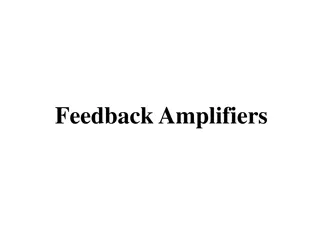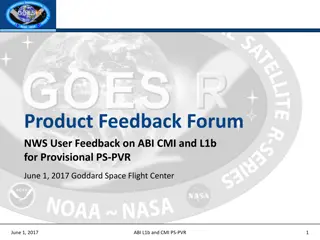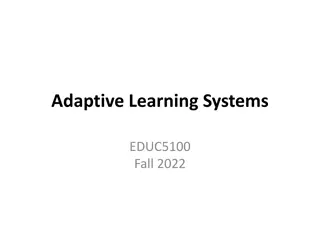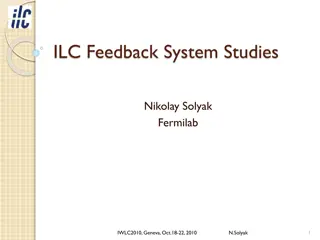
Solar X-Ray and EUV Sensors in Space Weather Monitoring
Explore the critical role of GOES X-Ray and Extreme Ultra Violet Sensors in monitoring solar irradiance, impacting communication, satellite orbits, and space weather phenomena. Understand the importance of measuring solar flux variations and their effects on the Earth's atmosphere.
Uploaded on | 3 Views
Download Presentation

Please find below an Image/Link to download the presentation.
The content on the website is provided AS IS for your information and personal use only. It may not be sold, licensed, or shared on other websites without obtaining consent from the author. If you encounter any issues during the download, it is possible that the publisher has removed the file from their server.
You are allowed to download the files provided on this website for personal or commercial use, subject to the condition that they are used lawfully. All files are the property of their respective owners.
The content on the website is provided AS IS for your information and personal use only. It may not be sold, licensed, or shared on other websites without obtaining consent from the author.
E N D
Presentation Transcript
Peer Stakeholder-Product Validation Review (PS-PVR) GOES 18 EXIS XRS and EUVS: User Perspective 27 November, 2022 Rodney Viereck University of Colorado, CIRES NOAA/NWS Space Weather Prediction Center Outline: Sensors Applications Issues Status
Solar X-Ray and EUV Irradiance Highly Variable X-Ray Variations of order 105 EUV Variations of order 2 to 50 Absorbed in the Upper Atmosphere Between 80 and 1000 km. Results in very large changes in the thermosphere (neutral density) and ionosphere (electron density) Direct Impacts: Radio communication Satellite orbits and drag Indirect Impacts Satellite navigation (GPS) Other space weather (geomagnetic storms and solar radiation storms) 2022-11-27 GOES 18 EXIS PS-PVR 2
GOES Solar X-Ray Sensor (XRS) Provide measurement of the magnitude and location* of solar flares. Requirements: Monitor the disk-integrated solar flux in two x-ray wavelengths. XRSA 0.05 nm 0.4 nm XRSB 0.1 nm 0.8 nm Three second cadence 10 second latency (actual latency is 30 sec.) Solar X-Rays: Change by several orders of magnitude in just a few minutes. Are absorbed in the lower ionosphere where the flare enhanced electron density blocks HF communication. * Note: Flare location is new to the GOES R series XRS. 2022-11-27 GOES 18 EXIS PS-PVR 3
GOES Solar Extreme UltraViolet Sensor (EUVS) The EUVS measures the solar energy input to the ionosphere and thermosphere. GOES EUV Requirement: Solar spectra from 5 to 120 nm 5 nm spectral resolution. 1 minute temporal resolution. Solar EUV irradiances change by factors of 2 to 50 on times scales of minutes to years. The thermosphere (neutral density) and ionosphere (electron density) change by similar amounts across all time scales. Unfortunately, the complexity of a sensor that could measure all wavelengths with the reliability to last the entire GOES mission and maintain calibration throughout would be cost prohibitive. 2022-11-27 GOES 18 EXIS PS-PVR 4
GOES 16 EXIS EUVS Measurements Primary Measurements Used in Spectral Model: Chromospheric: MgII C/W (EUVS-C) CIII 117.5 nm (EUVS-B) CII 133.5 nm (EUVS-B) Transition Region: Ly-alpha 121.6 nm (EUVS-B) SiIV/OIV 140.5 nm (EUVS-B), HeII 30.4 nm (EUVS-A) HeII 25.6 nm (EUVS-A) Corona: FeXV 28.4 nm (EUVS-A) Hot Coronal: 0.1-0.8 nm (XRS) 0.05-0.4 nm (XRS) From LASP (Eparvier) Note: The stability of the EUVS-C observations is applied to EUV-B to track performance and sensor degradation. 2022-11-27 GOES 18 EXIS PS-PVR 5
GOES X-Ray Sensor (XRS) and Extreme Ultra Violet Sensor (EUVS) X-Ray EUV FUV UV GOES XRS Bands 2022-11-27 GOES 18 EXIS PS-PVR 6 GOES EUVS Bands
Applications of the XRS . Nearly 50-years of continuous measurement of solar x-ray irradiance. Definitive measurement of the magnitude of solar flares. Critical for operations. Fundamental for solar research. Early warning for other space weather. Most major space weather events start with a large solar flare. Flare location and magnitude provide an estimate of the geo-effectiveness of an event. The size of a flare is strongly correlated with the magnitude of the resulting major space weather e.g. solar proton events and geomagnetic storms. The XRS data drive one of the three NOAA Space Weather Scales. R-Scale or Radio Blackouts - driven GOES solar x-rays S-Scale or Solar Radiation Storm driven by GOES solar protons G-Scale or Geomagnetic Storm Driven by USGS ground magnetometers Input to Space Weather Models D-Region Absorption Model (Specification of HF Radio Blackouts) Proton Prediction Model (Prediction of Radiation Storms). Ionosphere/Thermosphere models (to be added soon) 2022-11-27 GOES 18 EXIS PS-PVR 7
Application of the GOES EUVS data Air Force High Accuracy Satellite Drag Model (HASDM) Calculates and predicts neutral density and satellite position for collision avoidance Users: DOD, NASA, NOAA, Every satellite operator in the US NOAA Whole Atmosphere Model Ionosphere Plasmasphere with Electrodynamics (WAM-IPE based on the GFS weather model) Specify and predict ionosphere conditions for radio communication and satellite navigation. Specify and predict neutral density for satellite orbit predictions and collision avoidance. Customers: DOD, DHS/FEMA, FAA, ICAO, Satellites, Construction, Agriculture, Mineral Exploration, etc Status: Currently developing the appropriate interface between the GOES EUVS data and the operational WAM-IPE model GOES EUVS Data Will Become Even More Important: The recently formed DOC Office of Space Commerce will eventually include civil Space Traffic Management and Space Situational Awareness. This office will likely manage satellite drag models which will require solar EUV input from GOES to improve model performance. 2022-11-27 GOES 18 EXIS PS-PVR 8
XRS/EUVS Issues: Data latency GOES XRS 1-second data have latency of more than 30 seconds (due to unexpected data aggregation in the GRB). Impact: major (modifications to correct this are under consideration) Electron contamination GOES XRS data have significant electron contamination. Impact: minor (when corrected) Electron Correction During Minor Flare Proton contamination GOES XRS data have significant proton contamination. Impact: minor (when corrected) Not enough uninterrupted GOES 18 data to provide accurate trending and electron/proton corrections. Note that electron contamination only impacts the lowest values 2022-11-27 GOES 18 EXIS PS-PVR 9
GOES XRS and EUVS Status GOES 16 is currently the primary for XRS/EUVS sensors for operations. GOES 17 XRS is the secondary for XRS/EUVS sensors Backup for GOES 16 Coverage during periodic GOES 16 EUVS and XRS calibrations Coverage during fall and spring eclipse periods GOES 18 XRS/EUVS data are nearly ready for operations Sensor performance is good. Level 1 data are good Software to generate Level 2+ products has been installed and tested on the NWS operational IDP system. Still awaiting the implementation of updated LUTs for L1 data. Parameters for more accurate electron and proton contamination still need to be implemented in the L2 software. 2022-11-27 GOES 18 EXIS PS-PVR 10
Questions? 2022-11-27 GOES 18 EXIS PS-PVR 11



